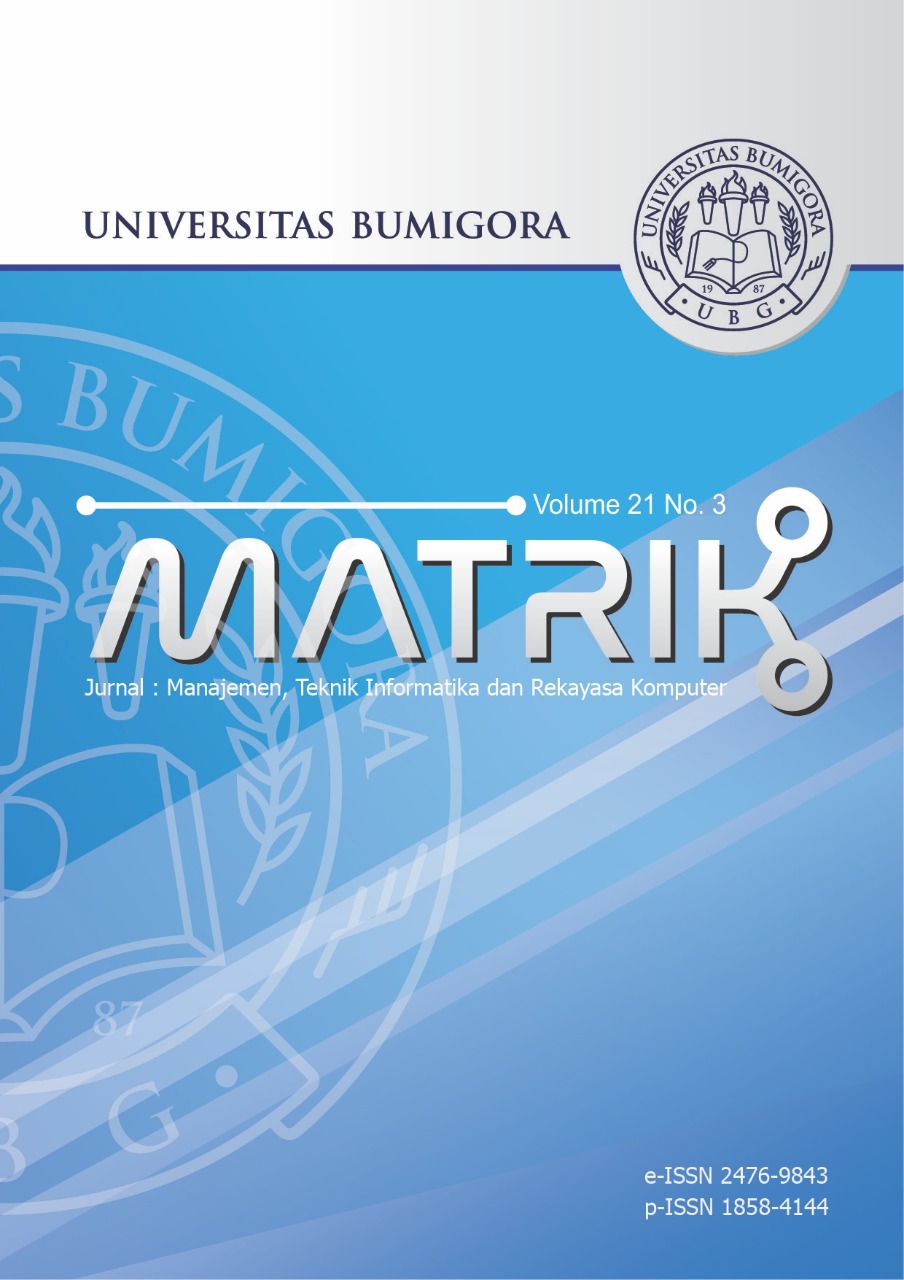Mobile Forensic of Vaccine Hoaxes on Signal Messenger using DFRWS Framework
DOI:
https://doi.org/10.30812/matrik.v21i3.1620Keywords:
Forensic, Cybercrime, Hoax, Signal Messenger, DFRWSAbstract
The COVID-19 pandemic is one of the factors that has increased the use of social media. One of the negative impacts of using social media is the occurrence of cybercrime. The possibility of cybercrime can also happen on one of the social media platforms, such as the Signal Messenger application. In the investigation process, law enforcement needs mobile forensic methods and appropriate forensic tools so that the digital evidence found on the perpetrator's smartphone can be accepted by the court. This research aims to get digital evidence from cases of spreading the COVID-19 vaccine hoaxes. The method used in this research is a mobile forensics method based on the Digital Forensic Research Workshop (DFRWS) framework. The DFRWS framework consists of identification, preservation, collection, examination, analysis, and preservation. The results showed that the MOBILedit tool could reveal digital evidence in the form of application information and contact information with a performance value of 22.22%. Meanwhile, Magnet AXIOM cannot reveal digital evidence at all. The research results were obtained following the expected research objectives.
Downloads
References
[2] D. PPI, “Survei Penetrasi Pengguna Internet di Indonesia Bagian Penting dari Transformasi Digital,†KOMINFO, 2020. [Online]. Available: ttps://www.kominfo.go.id/content/detail/30653/dirjen-ppi-survei-penetrasi-pengguna-internet-di-indonesia-bagian-penting-dari-transformasi-digital/0/berita_satker. [Accessed: 16-Nov-2020].
[3] K. Lutfiyah, “Review Article: Hoax and Fake News During Covid-19: Is the Law Effective in Overcoming it?,†Indones. J. Int. Clin. Leg. Educ., vol. 2, no. 3, pp. 345–360, 2020.
[4] A. D. Septiadi and L. S. Alfarizi, “Pemanfaatan E-KTP Sebagai Alat Bantu Sistem Kehadiran Pegawai dalam Penanggulangan Penyebaran Covid-19,†Matrik J. Manajemen, Tek. Inform. dan Rekayasa Komput., vol. 20, no. 1, pp. 159–168, 2020.
[5] H. Wijoyo, “Persepsi Mahasiswa Tentang Aplikasi Chatting Signal,†J. Teknol. dan Inf. Bisnis, vol. 3, no. 1, pp. 153–156, 2021.
[6] P. Rösler, C. Mainka, and J. Schwenk, “More is Less: On the End-to-End Security of Group Chats in Signal, WhatsApp, and Threema,†in IEEE European Symposium on Security and Privacy (EuroS&P), 2018, pp. 415–429, doi: 10.1109/EuroSP.2018.00036.
[7] S. M. Judge, “Mobile Forensics: Analysis of the Messaging Application Signal,†University of Central Oklahoma, 2017.
[8] M. B. Kilic, “Encryption Mesthods and Comparison of Popular Chat Applications,†Adv. Artif. Intellegence Res., vol. 1, no. 2, pp. 52–59, 2021.
[9] A. P. U. Siahaan, “Pelanggaran Cybercrime dan Kekuatan Yurisdiksi di Indonesia,†J. Tek. dan Inform., vol. 5, no. 1, 2018.
[10] P. Pahrudin, “Cybercrime in the Context of Cellular Telephone Scams,†J. Penelit. Pos Dan Inform., vol. 10, no. 1, pp. 73–85, 2020.
[11] A. Lee, “Online Hoaxes, Existential Threat, and Internet Shutdown: A Case Study of Securitization Dynamics in Indonesia,†(ISSH), J. Indones. Soc. Sci. Humanies, vol. 10, no. 1, 2020.
[12] A. T. Davina, S. Suseno, and M. Haffas, “Penerapan Hukum Penyebaran Hoax Mengenai Covid-19 Melalui Facebook Berdasarkan UU ITE dan Hukum Pidana,†Media Keadilan J. Ilmu Huk., vol. 12, no. 1, pp. 1–25, 2021.
[13] S. Harnett, “Health Literacy, Social Media and Pandemic Planning,†J. Consum. Health Internet, vol. 24, no. 2, pp. 157–162, 2020.
[14] KOMINFO, “Penanganan Sebaran Konten Hoax Covid-19,†2021.
[15] KOMINFO, “Penanganan Sebaran Konten Hoax Vaksin Covid-19,†2021.
[16] I. Riadi, R. Umar, and Firdonsyah, “Identification of Digital on Android’s Blackberry Messanger Using NIST Mobile Forensic Method,†Int. J. Comput. Sci. Inf. Secur., vol. 15, no. 5, pp. 155 – 160, 2017.
[17] A. Al-Dhaqm, S. A. Razak, R. A. Ikuesan, V. R. Kebande, and K. Siddique, “A Review of Mobile Forensic Incestigation Process Model,†IEEE, vol. 8, 2020, doi: 10.1109/ACCESS.2020.3014615.
[18] F. G. Hikmatyar and B. Sugiantoro, “Digital Forensic Analysis on Android Smartphones for Handling Cybercrime Cases,†Int. J. Informatics Dev., vol. 7, no. 2, pp. 64–67, 2018.
[19] A. Yudhana, I. Riadi, and I. Zuhriyanto, “Analisis Live Forensics Aplikasi Media Sosial pada Browser Menggunakan Metode Digital Forensic Research Workshop (DFRWS),†Techno, vol. 20, no. 2, pp. 125–130, 2019.
[20] I. Zuhriyanto, A. Yudhana, and I. Riadi, “Analisis Perbandingan Tools Forensic pada Aplikasi Twiter Menggunakan Metode Digital Forensics Research Workshop,†J. Resti (Rekayasa Dan Teknol. Informasi), vol. 4, no. 5, pp. 829–836, 2020.
[21] S. Pambanyun and I. Riadi, “Investigation on Instagram Android-based Using Digital Forensics Research Workshop Framework,†Int. J. Comput. Appl., vol. 175, no. 35, 2020.
[22] I. Riadi, Sunardi, and P. Widiandana, “Investigasi Cyberbullying pada WhatsApp Menggunakan Digital Forensics Research Workshop,†J. Resti (Rekayasa Dan Teknol. Informasi), vol. 4, no. 4, 2020.
[23] Sunardi, I. Riadi, and M. H. Akbar, “Penerapan Metode Statics untuk Ekstraksi File Steganografi pada Bukti Digital Menggunakan Framework DFRWS,†J. Resti (Rekayasa dan Teknol. Informasi), vol. 4, no. 3, pp. 576–583, 2020.
[24] S. Rani, “Digital Forensic Models: A Comparative Analysis,†Int. J. Manag. IT Eng., vol. 8, no. 6, 2018.
[25] A. L. Suryana, R. E. Akbar, and N. Widiyasono, “Investigasi Email Spoofing dengan Metode Digital Forensics Research Workshop (DFRWS),†J. Edukasi Penelit. Inform., vol. 2, no. 2, pp. 111–117, 2016.
[26] I. Anshori, K. E. S. Putri, and U. Ghoni, “Analisis Barang Bukti Digital Aplikasi Facebok Messeger pada Smartphone Android Menggunakan Metode NIJ,†IT J. Res. Deve;opment, vol. 5, no. 2, 2021.
[27] L. Widyawati, I. Riadi, and Y. Prayudi, “Comparative Analysis of Image Steganography using SLT, DCT and SLT-DCT Algorithm,†Matrik J. Manajemen, Tek. Inform. dan Rekayasa Komput., vol. 20, no. 1, pp. 169–182, 2020.
Downloads
Published
Issue
Section
How to Cite
Similar Articles
- Yana Safitri, Imam Riadi, Sunardi Sunardi, Mobile Forensic for Body Shaming Investigation Using Association of Chief Police Officers Framework , MATRIK : Jurnal Manajemen, Teknik Informatika dan Rekayasa Komputer: Vol. 22 No. 3 (2023)
- William Barkem, Jeckson Sidabutar, Digital Forensic Analysis of WhatsApp Business Applications on Android-Based Smartphones Using NIST , MATRIK : Jurnal Manajemen, Teknik Informatika dan Rekayasa Komputer: Vol. 22 No. 3 (2023)
- Firmansyah Firmansyah, Mochamad Wahyudi, Analisis Performa Access Control List Menggunakan Metode Firewall Policy Base , MATRIK : Jurnal Manajemen, Teknik Informatika dan Rekayasa Komputer: Vol. 20 No. 2 (2021)
- Imam Riadi, Abdul Fadlil, Muhammad Amirul Mu'min, OWASP Framework-based Network Forensics to Analyze the SQLi Attacks on Web Servers , MATRIK : Jurnal Manajemen, Teknik Informatika dan Rekayasa Komputer: Vol. 22 No. 3 (2023)
- Lathifatul Mahabbati, Andy Hidayat Jatmika, Raphael Bianco Huwae, Reducing Transmission Signal Collisions on Optimized Link State Routing Protocol Using Dynamic Power Transmission , MATRIK : Jurnal Manajemen, Teknik Informatika dan Rekayasa Komputer: Vol. 24 No. 1 (2024)
- Cindy Ameilia Suhendra, Marsani Asfi, Widya Jati Lestari, Ilwan Syafrinal, Sistem Peramalan Persediaan Sparepart Menggunakan Metode Weight Moving Average dan Reorder Point , MATRIK : Jurnal Manajemen, Teknik Informatika dan Rekayasa Komputer: Vol. 20 No. 2 (2021)
You may also start an advanced similarity search for this article.
Most read articles by the same author(s)
- Tugiman Tugiman, Herman Herman, Anton Yudhana, The UTAUT Model for Measuring Acceptance of the Application of the Patient Registration System , MATRIK : Jurnal Manajemen, Teknik Informatika dan Rekayasa Komputer: Vol. 22 No. 2 (2023)
- sri suharti, Anton Yudhana, Imam Riadi, Forensik Jaringan DDoS menggunakan Metode ADDIE dan HIDS pada Sistem Operasi Proprietary , MATRIK : Jurnal Manajemen, Teknik Informatika dan Rekayasa Komputer: Vol. 21 No. 3 (2022)
- Imam Riadi, Abdul Fadlil, Muhammad Amirul Mu'min, OWASP Framework-based Network Forensics to Analyze the SQLi Attacks on Web Servers , MATRIK : Jurnal Manajemen, Teknik Informatika dan Rekayasa Komputer: Vol. 22 No. 3 (2023)
- Imam Riadi, Herman Herman, Fitriah Fitriah, Suprihatin Suprihatin, Optimizing Inventory with Frequent Pattern Growth Algorithm for Small and Medium Enterprises , MATRIK : Jurnal Manajemen, Teknik Informatika dan Rekayasa Komputer: Vol. 23 No. 1 (2023)
- Alya Masitha, Muhammad Kunta Biddinika, Herman Herman, K Value Effect on Accuracy Using the K-NN for Heart Failure Dataset , MATRIK : Jurnal Manajemen, Teknik Informatika dan Rekayasa Komputer: Vol. 22 No. 3 (2023)
- Virdiana Sriviana Fatmawaty, Imam Riadi, Herman Herman, Higher Education Institution Clustering Based on Key Performance Indicators using Quartile Binning Method , MATRIK : Jurnal Manajemen, Teknik Informatika dan Rekayasa Komputer: Vol. 24 No. 1 (2024)
- Yana Safitri, Imam Riadi, Sunardi Sunardi, Mobile Forensic for Body Shaming Investigation Using Association of Chief Police Officers Framework , MATRIK : Jurnal Manajemen, Teknik Informatika dan Rekayasa Komputer: Vol. 22 No. 3 (2023)
- Lilik Widyawati, Imam Riadi, Yudi Prayudi, Comparative Analysis of Image Steganography using SLT, DCT and SLT-DCT Algorithm , MATRIK : Jurnal Manajemen, Teknik Informatika dan Rekayasa Komputer: Vol. 20 No. 1 (2020)


.png)












